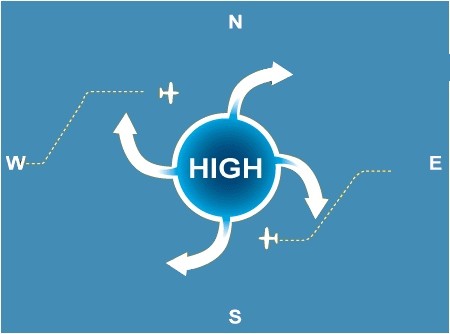Pressure: Difference between revisions
From Aviation Wiki
Jump to navigationJump to search
No edit summary |
No edit summary |
||
| Line 1: | Line 1: | ||
Falling pressure indicates poor weather coming. Increase in pressure indicates better weather. | Falling pressure indicates poor weather coming. Increase in pressure indicates better weather. </br> | ||
When flying from east to west, favourable winds will be to the south of a high or to the north of a low. | |||
[[File:Flying around a high.jpg]] | |||
==ISA== | ==ISA== | ||
29.92" HG or 1013.2 millibars or 101.3kpa at 15°C. | 29.92" HG or 1013.2 millibars or 101.3kpa at 15°C. | ||
Latest revision as of 14:09, 22 March 2014
Falling pressure indicates poor weather coming. Increase in pressure indicates better weather.
When flying from east to west, favourable winds will be to the south of a high or to the north of a low.

ISA
29.92" HG or 1013.2 millibars or 101.3kpa at 15°C.
A column of air one square inch in cross-section, measured from sea level to the top of the atmosphere, would weigh approximately 14.7lbs.[1]
"From high to low, look out below." This means that flying from a high pressure system to a low pressure system, you will be at a lower altitude than your altimeter reads if you never adjusted the pressure setting. The same applies to flying from warm air to cold air.